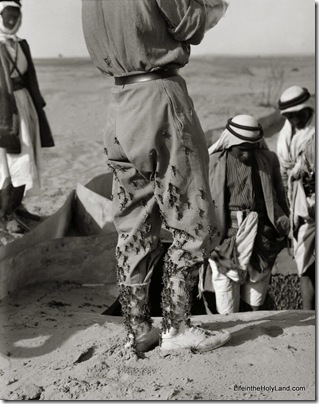John Whiting described the capture of locusts in “Jerusalem’s Locust Plague,” published in National Geographic in 1915:
“The fighters now made two long lines, one on each side of the trap. To noise and racket the locusts seemed only to turn a deaf ear; but a large flag—the darker the better—with which to cast a deep shadow upon the ground, proved to be the most formidable tool one could employ to make them move in the desired direction; in fact, countless numbers could thus be guided and held in check if one but anticipated the general direction they wished to go.”
“In their path was sunk a bottomless box, the inside lined with shining tin, up which the locusts could not crawl, while on each side a wing was provided, similarly prepared with a smooth metal face, with the object of directing them into the box.”
“Once, however, they made in the right direction, they jumped, hundreds at a time, into this death trap. . . . Thus in about an hour’s time four large sacks full were caught and destroyed each containing no less than 100,000 of these insects” (535-36).
“Whenever touched, or especially when finding themselves caught within one’s clothes, they exuded from their mouth a dark fluid, an irritant to the skin and soiling the garments in a most disgusting manner. Imagine the feeling (we speak from experience) with a dozen or two such creatures over an inch long, with sawlike legs and rough bodies, making a race-course of your back!” (533).
The photos and quotations are taken from an extraordinary collection of 80 photographs of locust plagues that occurred in Palestine in the early 1900s, now published on the Traditional Life and Customs volume of The American Colony and Eric Matson Collection (Library of Congress, LC-matpc-01912 and LC-matpc-02938).

